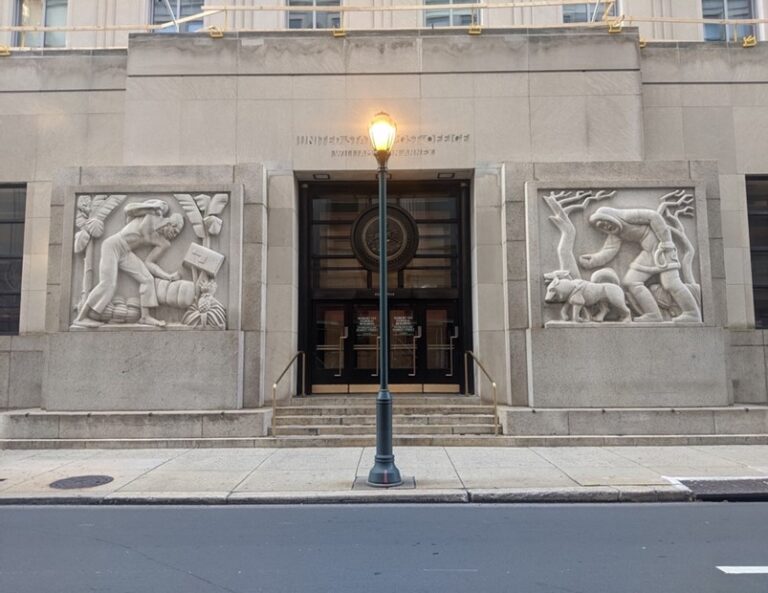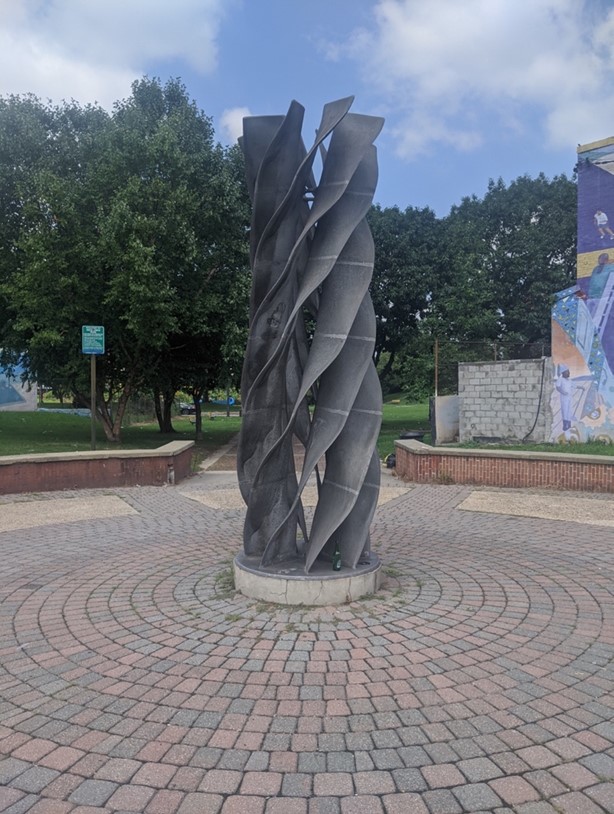Percent for Art Programs
By Josh Silver
Essay
Philadelphia was the first American city, in the wake of various influences—including publicly supported art in post-World War II Italian cities—to establish “percent for art” programs, which require building developers to designate funds for public art. Philadelphia’s programs became models for other communities and a means of improving neighborhood aesthetics. Although the programs experienced resistance from developers and others who balked at their costs and rules, subsequent accommodations to political and aesthetic objections allowed them to persevere and thrive.
Philadelphia’s initiatives largely derived from lawyer Michael von Moschzisker (1918-95) and his concerns with what he saw as aesthetically drab post-World War II urban renewal, driving his belief that “efficiency experts now find that beauty increases productivity” so “that true functionalism in man-made edifices must include artistic expression.” In 1959, as chairman of the city’s quasi-governmental Philadelphia Redevelopment Authority (PRA), he began a percent policy that constituted the first city-government related program in the nation to fund public art. Shortly thereafter, Philadelphia’s city government passed a law that initiated the second “percent” program in urban America. Both efforts mandated that developers had to supply up to 1 percent of the cost of various redevelopments for public art at their sites, respectively for work on land owned wholly or partially by the PRA and building undertaken with city funding.

The program’s early decades brought successes such as “Family of Bears” in Society Hill, by sculptor Sherl Joseph Winter (1934-2020), and the monumental “Clothespin” by Claes Oldenburg (1929-2022) across from Philadelphia’s City Hall, both of which became beloved works.
Despite these advances, political headwinds emerged against the percent programs, often in terms of proposed works seen as artistically elitist—as with the now-legendary sculpture “Government of the People” by Jacques Lipchitz (1891-1973). Program costs also encountered resistance from developers, as occurred with the work “Open Air Aquarium,” at the Dockside residences on the Delaware River.

Budgetary Challenges
Officials also questioned the cost and practicality of art. During the 1970s, Mayor Frank Rizzo (1920-91), noting the city’s population decline, resultant losses in its tax base, and increased social service and labor expenses, concluded that public art was a luxury the city could not afford. In 2004 Mayor John Street (b. 1943) closed the city’s Office of Arts and Culture following a major budgetary challenge, although it was revived in a new form four years later.
Additionally, internal limitations of percent programs undercut their effectiveness. For example, for many years architects and developers could choose any artist they wanted, which led to a lack of competition for artists.
While the PRA required spending of 1 percent or more, the city mandate’s requirement of spending up to 1 percent on art led at times to weaker efforts to uphold its law. At the same time, both programs have been understaffed, limiting their capacity for advice and oversight.

Still, support for percent programs remained, with perhaps the main reason being awareness of the arts as economic engines. Key examples of this came in the 1980s through the early twenty-first century during the mayoral administrations of W. Wilson Goode (b. 1938), Edward G. Rendell (b. 1944), and Michael Nutter (b. 1957).
In another evolution, the PRA experimented with new ways of presenting art, including community-based performances instead of traditional static art. Additionally, it began to choose the majority of its artists through “requests for qualifications” instead of “curated selection,” thus allowing consideration of more artists. It also divided larger percent projects into smaller ones to increase the number of artists at a site. Achievements in the city’s percent program included streamlining paperwork to realize more projects, successfully lobbying for older artworks’ conservation, and a 2015 guidebook to promote Philadelphia’s public art.

By bringing high-quality art to low-income communities and/or those of color, percent programs have contributed to social equity. In recent years, working-class residents gained more influence in art choices, largely with the PRA initiating a community education and participation requirement for its public art in 2010.
Philadelphia’s measures have influenced other governments to fund art. Although examples of other programs in the Philadelphia area are rare—including a public art component in the city of Lancaster and the state of New Jersey’s “Arts Inclusion” program—the city’s requirements have set a template for at least 350 programs nationwide.
In 2019 both of Philadelphia’s programs celebrated their sixtieth anniversaries, but their existence was endangered by a budget deficit due to the public health crisis that begin in 2020. Still, they persevered. City activities were relocated within the city Managing Director’s Office, and PRA art pursuits were placed within the Philadelphia Housing Development Corporation. As of early 2022, more than 350 works had been achieved through PRA/PHDC pursuits and completed within the city’s public art enterprise.
Joshua Silver is a historical researcher, occasional blogger on urban subjects, and a longtime guide to historical sites and public art in Philadelphia. (Author information current at time of publication.)
Copyright 2023, Rutgers University.
Gallery
Backgrounders
Links
- Percent for Art (Philadelphia Office of Arts, Culture, and the Creative Economy)
- Percent for Art Locations (Open Data Philly)
- Commotion Festival June 16-30 – The Redevelopment Authority’s Risk-Taking Temporary Public Art Project (The Art Blog)
- Missing Public Art Work Of Progress Plaza Uncovered (Hidden City Philadelphia)
- The City of Philadelphia Celebrates 60 Years of Percent for Art (Philly.gov)
- State Percent for Art Programs (National Assembly of State Arts Agencies)
- Association for Public Art













